By Laura Williams
 With spring on the horizon, farming is on my mind. But with the ground still frozen, I must wait until my fingers can comb the soil to plant lettuce, tomatoes, and peppers. That’s why I make it a ritual to produce a batch of kimchi to help me through the winter months. What I now realize is that the process of making kimchi mirrors working on the farm.
With spring on the horizon, farming is on my mind. But with the ground still frozen, I must wait until my fingers can comb the soil to plant lettuce, tomatoes, and peppers. That’s why I make it a ritual to produce a batch of kimchi to help me through the winter months. What I now realize is that the process of making kimchi mirrors working on the farm.
The Planning
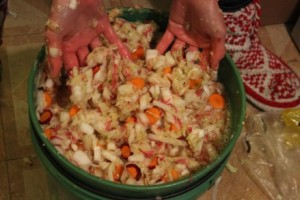 As I put my hand through five inches of salty brine, I think about the process that went into making these 5 gallons of fermented food. Although the actual making of the kimchi only took a day, and the fermentation only took a week, the true start of this project began over a full year ago while perusing seed catalogs.
As I put my hand through five inches of salty brine, I think about the process that went into making these 5 gallons of fermented food. Although the actual making of the kimchi only took a day, and the fermentation only took a week, the true start of this project began over a full year ago while perusing seed catalogs.
The same can be said for the preparation of the farm season. The mental work of crop planning, field mapping, and seed ordering begins months in advance of any physical work on the farm. The decision-making process that yields the best ferment—choosing the spiciest of daikon radish, the juiciest napa cabbage, the sweetest carrots and the earliest cayenne peppers— is the same process that goes into selecting for the highest yielding sweet pepper and the most tender heads of lettuce that the farm will grow next season.
The Prep
Just as I sharpen knives, wash jars, and clear off counter space for this relatively large-scale kitchen project, the farm season also requires a similar preparation in the spring. The tool shed gets cleaned out and organized, the fields get disked and amended, and the heat in the greenhouse gets turned on. Having space prepped and organized is an important part of starting the farm season and kimchi making!
The Recipe
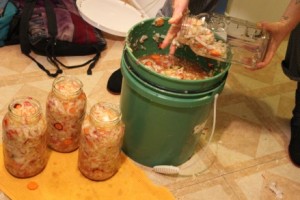 As I pack the finished ferment into the half gallon ball jars, I reflect on the recipe that created the framework for this project (see below for my full recipe). Each year I tweak and stretch this traditional Korean staple to better reflect the season on the farm. Living in Vermont, a couple hundred miles from the ocean, I have decided to leave out the typical seaweed and fish additions, and instead include turnips and kohlrabi that are in excess the previous fall.
As I pack the finished ferment into the half gallon ball jars, I reflect on the recipe that created the framework for this project (see below for my full recipe). Each year I tweak and stretch this traditional Korean staple to better reflect the season on the farm. Living in Vermont, a couple hundred miles from the ocean, I have decided to leave out the typical seaweed and fish additions, and instead include turnips and kohlrabi that are in excess the previous fall.
Just as kimchi requires a recipe, farming requires to-do lists. Every Monday during the Farmer Training Program, the students and staff walk the fields and create a list of priorities for the farm work that week. The list is written on a large white board, ranked from greatest to least important, and serves as our “recipe” for what needs to happen on the farm that week.
The Work
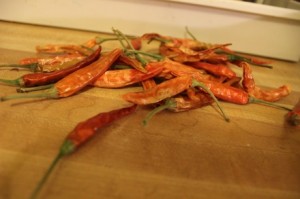 As I scoop the dripping pungency of chopped veggies, it calls to mind the actual work and perseverance that this kimchi project, and ultimately farming, entails. The chopping, the grating, the salting here in this kitchen parallels the hoeing, the pruning, the digging on the farm. The burning sensation in my eyes from slicing onions feels similar to the burn of sweat dripping in our eyes on a hot day working in the fields. The tingling of my fingers while de-seeding the hot peppers reminds me of the burn felt on our hands after spending hours harvesting these same hot peppers back in September. The background chatter heard over the public radio station throughout this day in the kitchen is familiar to the sounds of students talking and laughing while thinning the baby carrots in the field.
As I scoop the dripping pungency of chopped veggies, it calls to mind the actual work and perseverance that this kimchi project, and ultimately farming, entails. The chopping, the grating, the salting here in this kitchen parallels the hoeing, the pruning, the digging on the farm. The burning sensation in my eyes from slicing onions feels similar to the burn of sweat dripping in our eyes on a hot day working in the fields. The tingling of my fingers while de-seeding the hot peppers reminds me of the burn felt on our hands after spending hours harvesting these same hot peppers back in September. The background chatter heard over the public radio station throughout this day in the kitchen is familiar to the sounds of students talking and laughing while thinning the baby carrots in the field.
The Harvest
At the end of the day, the grated reds, chopped oranges, and pulverized greens fill the bucket to the brim; in the middle of the farm season the fields are filled with limitless colors including purples, pinks, and yellows. The work in the kitchen is almost done; the plantings and sowings are complete. Now we tend, we nurture, we wait. We practice patience and feel the anticipation of what’s to come. The first bite, the harvest, the reveal.
The vision that started a year ago is brought to fruition. Through this one mouth-watering, effervescent bite, I truly can feel in my body and spirit that it’s been a bountiful season!
Making Kimchi
Ingredient List
1 pound napa cabbage
1 daikon radish
2 carrots
2 onions
4 cloves garlic
4 hot peppers
3 tbsp ginger
Sea salt
Steps
1. Make a salt water brine by mixing 2 cups water and 2 Tbsp salt.
 |
2. Chop cabbage, radish, and carrots and soak the vegetables in the brine. Add other vegetables to the brine, such as kohlrabi and turnips, depending on your preference.
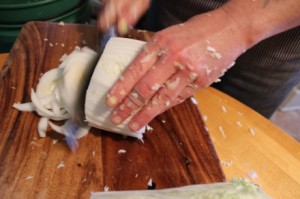 |
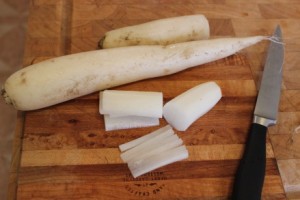 |
3. Grate ginger; chop onions, garlic and hot peppers. Remove seeds from the peppers first.
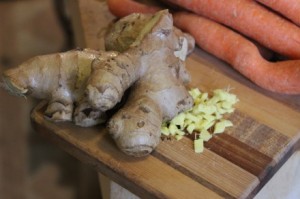 |
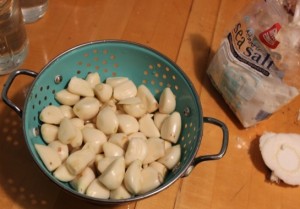 |
4. Blend these ingredients into a paste. Mix the spicy paste with the chopped, soaking vegetables.
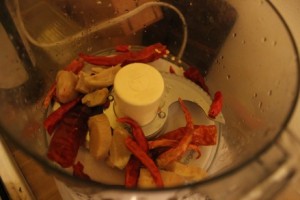 |
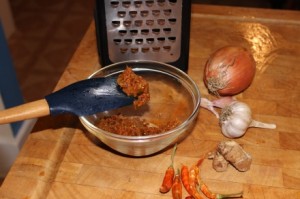 |
5. Put the well-mixed vegetables into a glass quart jar and pack the vegetables down so they become submerged under the brine. Cover the jar with a clean cloth to keep bugs and dust out.
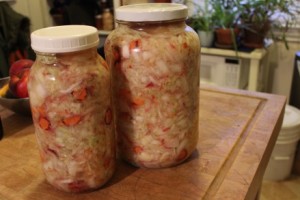 |
6. Place the ferment in a warm place in your kitchen and check on it daily. Make sure to push the vegetables under the brine every day with clean hands.
7. After about a week, taste the kimchi! If it tastes ready, move it to your refrigerator.
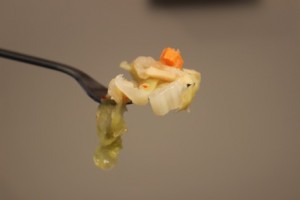 |
Laura Williams is the Farm Manager for Catamount Farm at the University of Vermont.










